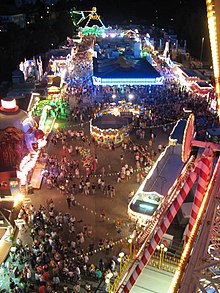Schützen- und Volksfest Fulda
Traditionally, the shooting and folk festival takes place on the Ochsenwiese in Fulda from the end of July to the beginning of August . Old documents prove that there was a shooting festival with an extensive booth town on the Fulda Rosenaue as early as 1327. As an integral part of the cultural course of the year in the baroque city, it attracts almost 130,000 visitors to the centrally located fairground every year.
Meaning and program
For the members of the shooting clubs , the event means maintaining tradition with a shooting festival . Every year a rifle king or a rifle queen is proclaimed, the royal family is received in the city palace by the mayor Fuldas as patron of the festival. There is a pageant to the Ochsenwiese and a prize shooting for everyone (Bürgererschießen). The Schützenverein Fulda 1572 eV is the ideal sponsor of the festival and takes an active part in the supporting events. The supporting program of the Schützenfest is a large folk festival with the usual attractions such as rides , beer tapping and a marquee .
Program highlights of the 10-day event are the two fireworks on the opening Friday and the second Friday, a ladies night on Monday and the family day on Wednesday. Further items on the program are the solemn proclamation and the subsequent pageant through the city center, two Sunday morning pints and the festive service.
history
Already in 1327 shooting festival in Fulda
From records we know that shooting festivals took place as early as 1327, at the time of Ludwig the Bavarian , Holy Roman Emperor, and his friend Heinrich von Hohenberg , prince abbot of Fulda. That was at the time when the Würzburgers invaded the Fulda region near Hammelburg. Due to a call from the mayor of the city, all the guilds and rifle guilds gathered at the Löhersgraben in front of the Kohlhäuser Tor to take action against intruders. On the morning after Kaiser Heinrich Day, July 16, everyone marched to Würzburg. Because of the overwhelming power, which was led by Count Berthold von Henneberg, the Bishop of Würzburg, Wolfram , shook hands for peace. When the news of the peace offer became known, festivals were celebrated which were attended by friends and foes.
Festival place on the Rosenau
Those returning home came just in time for the celebration of the shooting festival, which always began with a festive celebration and a lot of noise on the Sunday after Saint Anne's Day. This year it was really bad. The joy of the abbot's salvation and the victory won without bloody sacrifices created the most exuberant festive mood. Many of the soldiers had stayed with friends or relatives in town to celebrate the festival, the knights of the neighborhood had stayed in the chambers that almost all of them had in town.
The fairground was on the Rosenau. The large meadow belonged to the monastery, which it released every year for this festival, also because the second hay harvest could take place quite early here on the Fulda. Whole streets with booths of all kinds grew out of the ground here in just a few hours. You could buy everything your heart desires, sweets and cakes for the children, toys of all kinds from Nuremberg, weapons and armor for the men and colorful fabrics, velvet and silk for the women.
There was plenty of entertainment on the fairground for those with enough money; games were performed in large tents, strange people and animals were to be seen for little chunks, sea women, a calf with two heads, giant snakes and crocodile skins and whatever it was. And in front of their splendor, the stallholders paced up and down with serious expressions, shouting and talking to the crowd as if the Last Judgment were at the door.
On the morning of the day a solemn mass was sung in the collegiate church, which the abbot himself held. Then it went in a festive procession through the city to the fairground. They marched through the middle, wider alley to the other end of the square to the shooting range, and the shooting began. The rifle guilds of the individual guilds took up positions at their stands, and the abbot shot the first shot at each stand. The Empress came to the shooting festival as a special guest of honor. The shooting was in full swing, and the curious crowded around the stands, for everyone was extremely curious about who would become the shooter king. There were also the women, sisters, and brides who could not advance far enough, and the guards had their troubles. Every good shot was greeted with loud shouts, and the shouting and noise was great. The shot was good, some had put two bolts in the middle of the mark, but in the excitement of missing the third, the third had really missed. Nobody had hit the mark three times. From 17th to 21st June 1939 was the last shooting festival before the Second World War.
After the war
Eugen Distel, the grandfather of the current organizer Heiner Distel, who has been the general contractor for the festival since 1990, was met with great skepticism when he proposed to the city of Fulda in 1948 to organize a folk festival. At that time the shock and destruction of the war were still too great. But Eugen Distel convinced the people of Fulda: he organized the festival - and the people from the region came and found relaxation and distractions. Merry-go-rounds and booths were initially located on the Fuldaaue in the Langenbrückenstraße area until the mid-1950s. In 1953/54 the festival moved to its current location on the Ochsenwiese in the heart of the city.









